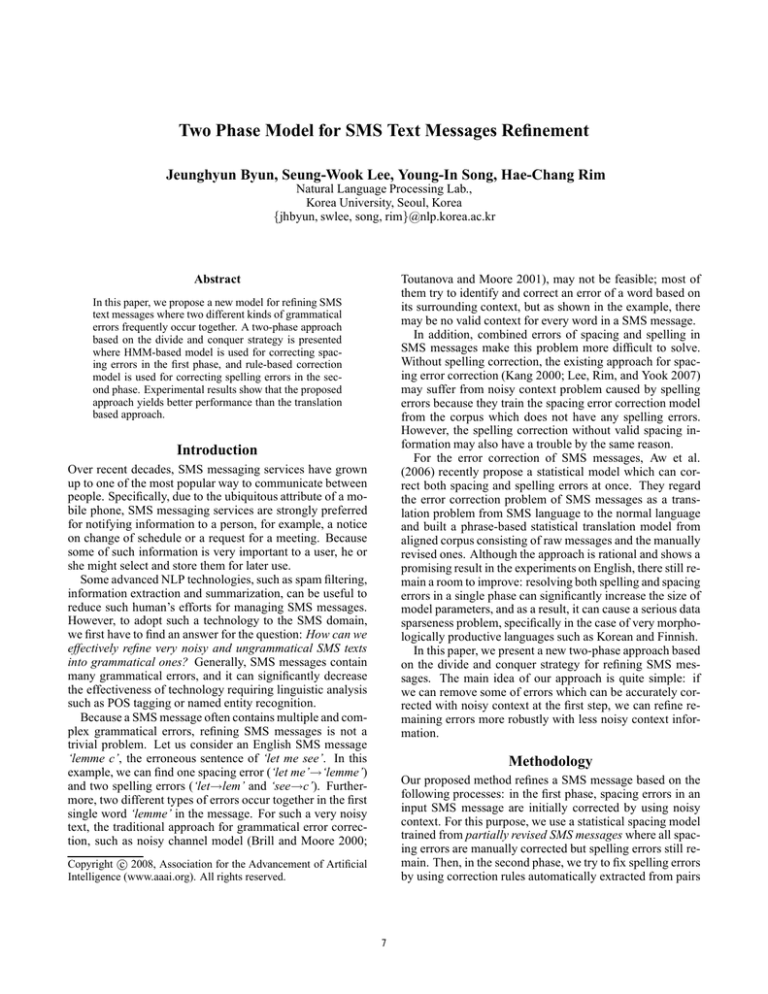
Two Phase Model for SMS Text Messages Refinement
Jeunghyun Byun, Seung-Wook Lee, Young-In Song, Hae-Chang Rim
Natural Language Processing Lab.,
Korea University, Seoul, Korea
{jhbyun, swlee, song, rim}@nlp.korea.ac.kr
Toutanova and Moore 2001), may not be feasible; most of
them try to identify and correct an error of a word based on
its surrounding context, but as shown in the example, there
may be no valid context for every word in a SMS message.
In addition, combined errors of spacing and spelling in
SMS messages make this problem more difficult to solve.
Without spelling correction, the existing approach for spacing error correction (Kang 2000; Lee, Rim, and Yook 2007)
may suffer from noisy context problem caused by spelling
errors because they train the spacing error correction model
from the corpus which does not have any spelling errors.
However, the spelling correction without valid spacing information may also have a trouble by the same reason.
For the error correction of SMS messages, Aw et al.
(2006) recently propose a statistical model which can correct both spacing and spelling errors at once. They regard
the error correction problem of SMS messages as a translation problem from SMS language to the normal language
and built a phrase-based statistical translation model from
aligned corpus consisting of raw messages and the manually
revised ones. Although the approach is rational and shows a
promising result in the experiments on English, there still remain a room to improve: resolving both spelling and spacing
errors in a single phase can significantly increase the size of
model parameters, and as a result, it can cause a serious data
sparseness problem, specifically in the case of very morphologically productive languages such as Korean and Finnish.
In this paper, we present a new two-phase approach based
on the divide and conquer strategy for refining SMS messages. The main idea of our approach is quite simple: if
we can remove some of errors which can be accurately corrected with noisy context at the first step, we can refine remaining errors more robustly with less noisy context information.
Abstract
In this paper, we propose a new model for refining SMS
text messages where two different kinds of grammatical
errors frequently occur together. A two-phase approach
based on the divide and conquer strategy is presented
where HMM-based model is used for correcting spacing errors in the first phase, and rule-based correction
model is used for correcting spelling errors in the second phase. Experimental results show that the proposed
approach yields better performance than the translation
based approach.
Introduction
Over recent decades, SMS messaging services have grown
up to one of the most popular way to communicate between
people. Specifically, due to the ubiquitous attribute of a mobile phone, SMS messaging services are strongly preferred
for notifying information to a person, for example, a notice
on change of schedule or a request for a meeting. Because
some of such information is very important to a user, he or
she might select and store them for later use.
Some advanced NLP technologies, such as spam filtering,
information extraction and summarization, can be useful to
reduce such human’s efforts for managing SMS messages.
However, to adopt such a technology to the SMS domain,
we first have to find an answer for the question: How can we
effectively refine very noisy and ungrammatical SMS texts
into grammatical ones? Generally, SMS messages contain
many grammatical errors, and it can significantly decrease
the effectiveness of technology requiring linguistic analysis
such as POS tagging or named entity recognition.
Because a SMS message often contains multiple and complex grammatical errors, refining SMS messages is not a
trivial problem. Let us consider an English SMS message
‘lemme c’, the erroneous sentence of ‘let me see’. In this
example, we can find one spacing error (‘let me’→‘lemme’)
and two spelling errors (‘let→lem’ and ‘see→c’). Furthermore, two different types of errors occur together in the first
single word ‘lemme’ in the message. For such a very noisy
text, the traditional approach for grammatical error correction, such as noisy channel model (Brill and Moore 2000;
Methodology
Our proposed method refines a SMS message based on the
following processes: in the first phase, spacing errors in an
input SMS message are initially corrected by using noisy
context. For this purpose, we use a statistical spacing model
trained from partially revised SMS messages where all spacing errors are manually corrected but spelling errors still remain. Then, in the second phase, we try to fix spelling errors
by using correction rules automatically extracted from pairs
c 2008, Association for the Advancement of Artificial
Copyright Intelligence (www.aaai.org). All rights reserved.
7
of a partially revised SMS message and its corresponding
fully revised reference. To train a model and extract correction rules, we manually built two different kinds of revised
corpus, partially revised corpus and fully revised corpus, for
the same SMS message corpus. We will provide further descriptions for each phase in detail.
Table 1: Candidate-Elimination Algorithm to Extract Correction Rules
1. Generate every possible correction rule candidate with
various context size by comparing every Pi and corresponding Fi .
2. Apply every correction rule candidate to the partially
revised corpus, and then estimate the precision of each rule.
3. Eliminate rule candidates whose accuracy is lower than
the threshold.
4. Select the rule candidate with the shortest context among
the candidates which can correct same spelling errors.
HMM-based Spacing Model
To correct spacing errors in the first phrase, we select the
HMM-based spacing approach proposed by Lee, Rim, and
Yook (2007) because it shows very robust performance with
limited information. In order to train a model with noisy data
where only a spacing error is corrected, such characteristics
of this model are very attractive.
The following equation shows the definition of HMMbased spacing model that we use:
p(ui,n |ci,n ) ≈
n
Y
Table 2: Performance comparison between the proposed
method and Aw et al. (2006). In the table, Acc(W) and
Acc(M) denote word-unit accuracy and message-unit accuracy respectively.
{p(ci |ci−2,i−1 , ui−2,i−1 )
Input text
After only spacing error correction
After only spelling error correction
After spacing and spelling error
correction(Proposed method)
Aw et al. (2006)
i=1
×p(ui |ci−1,i , ui−2,i−1 )}
(1)
where c denotes a character, u means a word-spacing tag indicating whether the current and next character should have
a space between them (u = 1) or not (u = 0). n indicates
length of an input message.
Acc(M)
1.16%
27.97%
6.61%
72.02%
32.00%
12.78%
Table 2 shows the experimental results. Input text is
very noisy as shown in the table. Compared to the baseline method, our method performs better in both word-unit
accuracy and message-unit accuracy. While the proposed
model is much simpler than the translation-based model, the
experimental results show that our two phase approach utilizing both partially-revised and fully-revised corpus is quite
effective for refining very noisy SMS-messages.
Rule-based Spelling error Correction Model
In the second phase, we simply use error correction rules
defined as follows:
R =< Cl , Si , Cr , Sc >
Acc(W)
16.15%
65.55%
24.29%
86.44%
(2)
where Si indicates an incorrect syllable found in a message,
Sc denotes the correct syllable for Si , and Cl and Cr means
the left and right context of Si respectively. Cl and Cr can
be a NULL or space as well as a syllable. For example, the
rule <‘le’,‘m’,‘ me’,‘t’>can correct ‘lem me’ to ‘let me’.
We automatically extract the correction rules from pairs
of a partially revised SMS message and its spelling revised
reference by using Candidate-Elimination Algorithm (Byun,
Park, and Rim 2007). Different from the first phase, an errorfree corpus not including any spelling or spacing error is
used for rule extraction. Table 1 shows our rule extraction
method. In the table, Pi indicates the ith partially revised
SMS message, Fi indicates the ith fully revised reference
for Pi .
We apply the correction rules with the longest matching
strategy when refining a SMS message.
References
Brill, E., and Moore, R. C. 2000. An improved error
model for noisy channel spelling correction. In ACL ’00:
Proceedings of the 38th Annual Meeting on Association
for Computational Linguistics, 286–293. Morristown, NJ,
USA: Association for Computational Linguistics.
Byun, J.; Park, S.-Y.; and Rim, H.-C. 2007. Automatic spelling correction rule extraction and application for
spoken-style korean text. In Proceedings of the 6th International Conference on Advanced Language Processing and
Web Information Technology, 195–199.
Kang, S.-S. 2000. Eojeol-block bidirectional algorithm for
automatic word spacing of hangul sentences. Journal of
Korea Information Science Society 27(4):441–447.
Lee, D.-G.; Rim, H.-C.; and Yook, D. 2007. Automatic
word spacing using probabilistic models based on character
n-grams. IEEE Intelligent Systems 22(1):28–35.
Toutanova, K., and Moore, R. C. 2001. Pronunciation
modeling for improved spelling correction. In ACL ’02:
Proceedings of the 40th Annual Meeting on Association
for Computational Linguistics, 144–151. Morristown, NJ,
USA: Association for Computational Linguistics.
Experiments
To evaluate our proposed approach, we have conducted several experiments on Korean SMS message corpus, which
consists of about 100,000 raw SMS messages and their revised messages. The SMS messages used in our experiments
were gathered from real users. In order to compare the previous approaches, we have reimplemented the translationbased approach proposed by Aw et al. (2006) and used it as
a baseline system.
8


